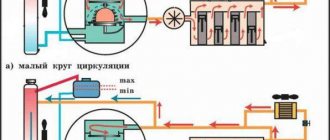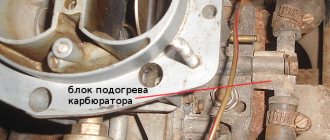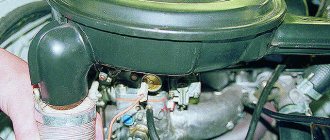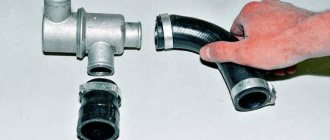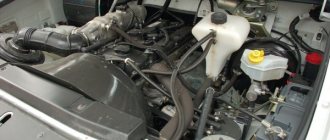The thermostat in the car has gone bad, I’m going to go to the store in a couple of days, but I want to know how to choose the right thermostat, what to look for, what nuances there are, I’ll be glad for any advice!
I’ll tell you, as a long-time car enthusiast, you should only buy original spare parts from the manufacturer.
The thermostat is no exception.
After all, the work of one node directly affects the work of other nodes and it is necessary to make some “improvements” either in a comprehensive manner, or to refrain from doing so altogether.
First of all, you need to remove the thermostat to get an idea of what it looks like.
Further information is needed.
Manufacturer country. in our case it is Russia. City of Togliatti.
This means that the original thermostat is produced at the Volzhsky Automobile Plant, we are not considering a license, imported ones and especially Chinese ones are the same.
Next we look for information about the price. You can go online, you can go to several stores.
Based on the price, we find out about the cheapest ones and immediately exclude them (probably Chinese).
Then we exclude the most expensive ones; VAZ thermostats for classics can also be produced by France (for example), the price is higher, but the quality is no better, and often worse.
Next, we collect information; all classic models up to 7 have the same thermostats, which means we don’t get hung up on the 6.
Suitable from 01, 02, 03, 04, 05, 0.63, 07.
The original packaging must have the VAZ logo, it looks like this.
Now look at the removed thermostat, only the series numbers and production dates should differ, all other numbers should match.
This is the main thing.
Of course, there are thermostats of good quality produced under license, in this case you just need to find out whether this manufacturer has a VAZ license.
The efficiency of the stove and other parameters that affect the operation of the entire engine depend on the engine temperature. The temperature depends on the thermostat. A thermostat is a device that directs coolant through a large or small cooling circle.
Thermostat
A thermostat is a device that regulates temperature. Essentially, it is a shut-off and control device that opens, closes and changes the direction of flow of coolant. There are two cooling circuits in a car engine cooling system: large and small. The large circle is the circulation of fluid through the main radiator, and the small circle is the circulation of fluid bypassing the radiator.
The operation of the thermostat is regulated by a valve, which, depending on the temperature, opens one pipe and closes the second.
What kind of thermostat VAZ-2114
The efficiency of the stove and other parameters that affect the operation of the entire engine depend on the engine temperature. The temperature depends on the thermostat. A thermostat is a device that directs coolant through a large or small cooling circle.
- What is a thermostat?
- Engine cooling system diagram.
- Types of thermostats for VAZ.
- Injection thermostats.
- Which thermostat is better for VAZ 2114?
- Video.
Types of thermostats
Externally, if you take the thermostats of the Niva and VAZ 2101 (kopecks), the differences will not be visible. They have differences inside, the pipes are located differently.
Types of VAZ thermostats:
- Thermostat 2101-2107. The valve began to lock when it reached 80 degrees, and fully opened when it reached 95 degrees.
- Almost the same ones are installed on the VAZ Niva, only the angle between the pipes is about 180 degrees.
- The VAZ 2108 thermostat is installed on all VAZ models with carburetor engines of various modifications. The thermostat valves of front-wheel drive VAZs operate 7 degrees later than those of classic models.
- The thermostat of the VAZ 2110 is the same as the classic one, but the pipes are located in a mirror image. There is no small pipe for air outlet.
- The VAZ 2112 thermostat is made for VAZ injection engines. The valve opens when the temperature reaches 85 degrees.
Keep the temperature!
KEEP THE TEMPERATURE!
The thermostat is a simple device. But very important. Errors when replacing it are unacceptable.
The thermostat in the engine is used to maintain the proper temperature in the cooling system. But its functions are not limited to this: power, fuel consumption, exhaust emissions, and the efficiency of the heater all depend on a simple device. And also durability, engine life.
On all VAZ cars, the thermostat is removed from the engine block head and is an independent element. Today we know the following models:
2101 - all VAZ “classics” are equipped with these, starting with the first-born VAZ 2101. The valve begins to open at a temperature of 80±2°, and is fully open at 95±2°. A distinctive feature of the “first” thermostat is that the pipes are rotated relative to each other at an angle of slightly more than 90 degrees (photo 1 on the left).
2121 - for Niva. In terms of filling, the thermostat is practically “zero first”. Only due to the layout features, its pipes are located on the body at an angle of almost 180 degrees. By the way, the modernized Niva VAZ 21213 has a thermostat 2101.
2108 - the next generation of thermostats (photo 1 in the center) - intended for Samara engines. The latter have a more advanced combustion chamber shape and a higher compression ratio; their temperature regime is 7° higher than the classic ones. This improves the power and economic characteristics of the machine. The “eight” thermostat begins to open at 87°, and is fully open at 102°. True, today on the market there are “eighth” thermostats with a valve opening temperature of 85°. It’s easy to explain: the quality of thermostats today is not up to par; the valve often opens with a delay, creating a risk of engine overheating. So they dropped two degrees. "in reserve."
Thermostat 2108 pipes are located almost like at “zero first”, but seem to be mirrored in relation to it. In addition, closer to the bottom, the “eighth” has an additional thin pipe for connection to the expansion tank (see photo 1 in the center). This is the path for air bubbles to exit the cooling system if they somehow get there.
2110 - structurally repeats the “eight”, it has almost the same characteristics (circulation in the “large circle” will begin at 87 or 85°). Externally, it is even more similar (but also a mirror image, do not confuse it!) with “zero first”, since it does not have an additional thin pipe (photo 1, right).
On the VAZ 2110, the “road” for air was paved from the tee adjacent to the thermostat. The latter is intended for cars with carburetor engines (VAZ 2110 and 21111). If necessary, you can also install a “figure eight” thermostat on them, you just need to thoroughly plug its air pipe.
It happens that manufacturers of these products arbitrarily simplify the design, so when buying a thermostat, look into it. At the top of the housing there should be a vertical strip of metal or plastic, resembling a curtain, which covers the additional valve in a sector of approximately 270° (photo 2). Without this curtain, the liquid mixes less well, heats the thermoelectric element less and more slowly - and the thermostat switches to the “large circle” with a delay at elevated temperatures.
2112 - next generation thermostat - for injection engines (photo 3). It differs from the previous ones in that, in addition to the main function, it also increases the efficiency of the heater. For this purpose, the resistance of the “small circle” was increased, thereby forcing the coolant to flow more intensively through the heater radiator. This thermostat has a throttle hole in the inlet pipe. The transition from “small” to “large circle” begins at a temperature of 85°. By the way, the temperature threshold for the start of operation of any thermostat is squeezed out on the bottom (photo 4).
Let's now move on to the sensor (photo 5) for turning on the electric fan of the cooling system. Today, two generations of sensors are produced - two-amp and twenty-amp. Moreover, each, in turn, is divided into two categories - for classics and for front-wheel drive models.
The first generation includes veteran sensors TM-108. Since they could not directly switch large currents, this role was assigned to a special power relay, triggered by a command from the sensor. For classics, this sensor had an index of 2103–3808800. Let's remember: the “treshka” was the first VAZ car without a constantly rotating mechanical impeller. Fan switch-on temperature is 92°, switch-off temperature is 87°.
As already noted, the Samara engine has a more severe temperature regime. Therefore, here the electric fan turns on at a higher temperature than the classic one. The sensor contacts (2108–3828010) close at 99° and open at 94°.
New generation sensors do not need the help of a power relay - they are able to switch current up to 20 A themselves. Their response temperatures remain the same, and the indices are 661.3710 (for classics, catalog number 2110-3828010-10) and 66.3710 (for Samara and "ten" with engines 21083, number 2110–3828010). At the same time, on all models “ten”, “Samar” and “Lada” the use of a new fuse block is provided - a European type.
They can be distinguished by the numbers stamped on the edges of the hex key. On new generation sensors the first digits of the marking are stamped: “661” (for classics) or “66” (for “samara” and “ten”), on old ones - TM-108. In any option, the response temperature must be indicated on the adjacent plane.
New sensors can be painlessly installed in place of old ones. On the contrary - under no circumstances! The “one hundred and eighth” contacts will simply burn out if they cannot withstand the high current. In a hypothetical situation - the sensor has failed, and only TM-108 is at hand - you will have to change the electric fan switching circuit by introducing a power relay into it.
As for injection engines (VAZ 2111 and VAZ 2112), their electric cooling system fan is controlled by a controller (“injection brains”). The latter measures the coolant temperature with one of its special sensors. Therefore, in the radiators of the cooling systems of these machines there is no sensor for turning on the electric fan.
PS When the number was being typed up, we were informed that changes were being made to the design of thermostat 2112. The inlet pipe will now have not one throttle hole in the center, but four, arranged in a cross, closer to the walls. In this case, when the valve is open, the liquid washes the thermal power element more reliably.
Thermostats of VAZ cars: 2101 - on the left, 2108 - in the center, 2110 - on the right.
A plastic curtain is visible in the area of the bypass (additional) valve.
Thermostat 2112. This is what the “small circle” throttle hole looks like.
The temperature at which the thermostat begins to operate is indicated on the bottom of the thermostat.
Sensor for turning on the electric fan of the cooling system.
Which thermostats to choose for VAZ (Lada) 2101/2103/2106?
Last month, PartReview users preferred LUZAR. 60% of positive votes belong to this manufacturer.
Gates thermostats came in second place with 20%.
Vernet closes the top three with 20% of the votes.
In the general rating of thermostats, which takes into account the opinions of owners of different brands and models of cars, these brands occupy the following positions:
- LUZAR received 8th place, PR score - 66. Data from 72 reviews and 229 votes are taken into account.
- Gates is ranked 10th with a PR score of 56 based on 72 reviews and 89 votes.
- Vernet is ranked 6th with a PR score of 70. Data from 66 reviews and 202 votes are taken into account.
How to check the thermostat on Lada Kalina
To check the thermostat on Lada Kalina cars, without dismantling, you can follow the algorithm described above. To begin, start the engine and touch the pipe connecting the thermostat and radiator. Until it reaches 90 degrees Celsius (controlled by the indicator on the dashboard), the pipe should be cold, and after that it should be warm.
To check the thermostat more accurately, it is advisable to remove it from the car.
To do this, take the following steps:
- Drain the antifreeze from the system.
- Remove the recirculation valve, as well as the sensor that controls the mass flow of fuel.
- Loosen the clamps and remove the four pipes from the required element of the system.
- Unscrew the nut and remove the wire connected to ground.
- Unscrew the fasteners and remove the thermostat from the mounting socket.
To check the Kalina thermostat at home, follow these steps:
- Secure and lower the device inside a pan that is filled with water.
- Make sure that the device does not touch the walls.
- Turn on the stove and heat the water.
- After the liquid boils, pay attention to the position of the valve - it should open.
- Wait for the water to cool and make sure the valve is closed.
Other spare parts for VAZ (Lada) 2101/2103/2106
Having found out which thermostats VAZ (Lada) 2101/2103/2106 owners prefer to install, you can look at other popular spare parts for this car. In June 2022, the leaders on PartReview were:
You can also find out what the owners of VAZ (Lada) 2101/2103/2106 chose among manufacturers of such spare parts as: Pump, Springs, Shock Absorber Struts, Brake Discs, Starter, and others.
If the VAZ 2106 engine suddenly began to overheat for no apparent reason, most likely the thermostat has failed. This is a very small device that at first glance seems insignificant. But this impression is deceptive: if there are problems with the thermostat, the car will not go far. Moreover, the engine, overheating, may simply jam. Is it possible to avoid these troubles and replace the thermostat yourself? Undoubtedly. Let's figure out how this is done.
Replacing the VAZ 2107 thermostat - step-by-step instructions
Hello dear readers of the Autoepoch.ru blog! Today I want to talk about replacing the VAZ 2107 thermostat.
Description, device and principle of operation.
The thermostat, also known as the “seven” thermostat, is a part that is a cylindrical container with three outlets for pipes. At the upper end of the part there is an inlet pipe from the engine, at the bottom there is an inlet pipe coming from the radiator, and the third outlet pipe is located on the top side. The thermostat device can be seen in more detail in the photo below.
Purpose of the thermostat on the VAZ 2106
The thermostat must control the degree of heating of the coolant and react in a timely manner when the antifreeze temperature becomes too high or, conversely, too low.
The device can direct coolant through either a small or large cooling circle, thereby preventing the engine from overheating, or, conversely, helping it quickly warm up after a long period of inactivity. All this makes the thermostat the most important element of the VAZ 2106 cooling system.
Thermostat location
The thermostat in the VAZ 2106 is located to the right of the engine, where the pipes for discharging coolant from the main radiator are located. To see the thermostat, simply open the hood of the car. The convenient location of this part is a big plus when it becomes necessary to replace it.
Principle of operation
As mentioned above, the main task of the thermostat is to maintain the engine temperature within specified limits. When the engine needs to warm up, the thermostat blocks the main radiator until the engine reaches the optimal temperature. This simple measure can significantly extend the life of the engine and reduce wear on its components. The thermostat has a master valve. When the coolant reaches a temperature of 70 °C, the valve opens (it should be noted here that the opening temperature of the main valve can be higher - up to 90 °C, and this depends both on the design of the thermostat and on the thermal filler that is in it used).
The second important element of the thermostat is a special compression cylinder made of brass, inside of which there is a small piece of technical wax. When the antifreeze in the system reaches 80 °C, the wax in the cylinder melts. As it expands, it presses on the long rod connected to the main thermostat valve. The rod extends from the cylinder and opens the valve. And when the antifreeze cools, the wax in the cylinder begins to harden, and its expansion coefficient decreases. As a result, the pressure on the rod weakens and the thermostatic valve closes.
By opening the valve here we mean moving its leaf by only 0.1 mm. This is the initial opening value, which consistently increases by 0.1 mm as the antifreeze temperature rises by two to three degrees. When the coolant temperature rises by 20 °C, the thermostat valve opens fully. The full opening temperature can vary from 90 to 102 °C depending on the manufacturer and design of the thermostat.
Design and functional properties
The materials for the manufacture of parts of the body and filling of the thermostat of the VAZ 2106 car are brass and copper. The working process of the thermostat is as follows:
- A spherical piece of wax is placed in the cylinder of the device, which begins to melt when the engine reaches a temperature mark of 82 ° C.
- Having a significant coefficient of expansion, the wax begins to press on the end of the rod connected to the inlet valve.
- When the valve opens, coolant begins to circulate through the heat removal lines of the engine, cooling it.
- As the temperature drops, the wax begins to harden and shrink, which leads to a decrease in pressure on the rod, which returns to its place under the action of the return spring.
Problems with the thermostat arise when the engine is operated in incorrect operating modes: frequent overheating, prolonged driving with engine hyperthermia, or mechanical deformation of the thermostatic device.
If the valve jams in the closed position, severe overheating of the power plant occurs even at negative ambient temperatures. When the valve is partially opened, overheating still occurs, but under gentle operating conditions this will not lead to the engine boiling.
When the shut-off valve of the car thermostat is in the fully open position, the engine cannot warm up to the temperature required for normal operation. In this case, the wear of parts of the crank and gas distribution mechanisms increases, the required degree of expansion of the cylinder-piston group is not achieved, which leads to insufficient sealing of the combustion chamber and a decrease in the degree of compression.
Types of thermostats
The VAZ 2106 car was produced for many years. And during this time, engineers made a number of changes to it, including thermostats. Let's look at what thermostats were installed on the VAZ 2106 from the release of the first cars to the present day.
Single valve thermostat
Single-valve thermostats were installed on the very first “sixes” that rolled off the VAZ assembly line. The operating principle of this device has been described in detail above. To date, these devices are considered obsolete, and finding them on sale is not so easy.
Electronic thermostat
An electronic thermostat is the latest and most advanced modification that replaced single-valve devices. Its main advantages are high accuracy and reliability. Electronic thermostats have two operating modes: automatic and manual.
Liquid thermostat
Thermostats are classified not only by design, but also by the type of fillers. Liquid thermostats were the very first to appear. The main component of a liquid thermostat is a small brass cylinder filled with distilled water and alcohol. The operating principle of this device is the same as that of the wax-filled thermostats discussed above.
Solid thermostat
The filler in such thermostats is ceresin. This is a substance similar in consistency to regular wax, which is mixed with copper powder and placed in a copper container. The cylinder has a rubber membrane connected to a rod, also made of dense rubber that is resistant to high temperatures. Ceresin, expanded from heating, presses on the membrane, which, in turn, acts on the rod and valve, ensuring the circulation of antifreeze.
Which thermostat is better
Today, thermostats based on solid fillers are considered the best option for the VAZ 2106, since they have the optimal combination of price and quality. In addition, they can be found in any auto store, unlike liquid single-valve ones, which are practically no longer on sale.
How to replace a thermostat?
In order to replace the thermostat on a VAZ 2106, you only need to prepare an ordinary screwdriver. Before starting dismantling work, you must remove the battery to avoid possible short circuit or electric shock.
Next you need to drain some of the coolant. To do this, remove the plug, which is located in the area of the cylinder block. After completing all these procedures, the thermostat should be directly replaced. Using a screwdriver, loosen the clamps (three pieces) that secure the pipes to the temperature control device. Now the thermostat itself is removed.
Before installation, the new device must be tested for serviceability and compliance with the correct temperature conditions for its operation. The test takes place in a container of water.
Unlike diagnosing an old thermostat (the test takes place in a liquid with a temperature of 95-100 °C), the new device is tested at a temperature not exceeding 87 °C.
Signs of a broken thermostat
There are a number of signs that clearly indicate that the thermostat is faulty:
- The light on the instrument panel is constantly on, indicating that the engine is overheating. This usually happens because the thermostat valve has closed and is stuck in that position;
- The engine warms up very poorly. This means that the thermostat valve does not close tightly. As a result, antifreeze flows through both the small and large cooling circles and cannot warm up in a timely manner;
- After the engine starts, the lower thermostat tube heats up literally within a minute. You can check this by simply placing your hand on the nozzle. This situation indicates that the thermostat valve is stuck in the fully open position.
If any of these symptoms are detected, the driver should replace the thermostat as soon as possible. If the car owner ignores the above symptoms, this will inevitably lead to overheating of the engine and its jamming. It is extremely difficult to restore an engine after such a breakdown.
Ways to solve problems
Possible solutions to the problem include:
1. If the coolant temperature exceeds the norm (provided the thermostat is working and it is correctly selected), it is necessary to replace the device, but with a higher opening temperature. As a rule, this step is recommended for motorists who operate cars in the mountains and in regions with hot climates.
2. When opening the thermostat late, it is important to ensure that there are no plugs and that the system is completely filled. If the problem is caused by a plug (coolant stagnation), then the best solution is to make a small hole in the plate (2-3 mm). As a result, the coolant flow around the thermostat is normalized, and the engine warm-up time increases.
3. Early opening of the thermostat is possible due to excessive pressure in the system. Zones of different pressure often appear around the device, which leads to its early operation. There are several reasons:
- failure of the cooling system;
- The thermostat spring has weakened;
- The engine runs at higher speeds during the warm-up period.
4. The engine takes too long to warm up.
- incomplete closing of the thermostat;
- violation of the integrity of the valve plate (for example, a gap has appeared);
- Incorrect position (possibly changing the location of the air valve).
5. The engine heats up above normal even in a situation where the thermostat is fully open:
- traffic jams or low coolant level;
- failure of the radiator (clogging of its cells);
- failure of the cooling pump or fan;
- contamination of the cooling system.
Methods for checking the thermostat
There are four main ways to test the thermostat's functionality. We list them in increasing order of complexity:
- The engine starts and idles for ten minutes. After this, you need to open the hood and carefully touch the lower hose coming out of the thermostat. If the device is working correctly, the temperature of the lower hose will not differ from the temperature of the upper one. After ten minutes of operation they will be warm. And if the temperature of one of the hoses is significantly higher, the thermostat is broken and needs to be replaced.
- The engine starts and idles. After starting the engine, you need to immediately open the hood and put your hand on the hose through which antifreeze enters the upper part of the radiator. If the thermostat is working properly, this hose will be cold until the engine warms up properly.
Video: checking the thermostat
Diagnosis of problems
To diagnose a thermostat malfunction, several steps must be taken.
- Warm up the car engine to 95-100 °C (when the thermometer needle slightly does not reach the red mark).
- Turn off the engine. Open the hood lid and find two radiator hoses.
- It is necessary to check their temperature, either by touch (extremely carefully) or with any instrument. If one of the hoses is cold, this indicates a malfunction of the thermostatic device and the need for its urgent replacement.
There is another way to check if the thermostat is working properly, but it involves completely removing the device from the car. The vehicle's thermostat is located in a container, which is filled with water heated to boiling water (100 °C).
After a short period of time, the shut-off valve should move to the open position. With this option, it is revealed that problems in the heat removal system are located in another node. If this does not happen, then the condition of the thermostat is determined to be unsatisfactory and requires replacement.
The operating temperature of the thermostat varies over a fairly wide range. Therefore, in order for the replacement to bring the expected results, you need to clarify the structural, technical and temperature characteristics of your vehicle before directly purchasing a temperature controller. Otherwise, the correct operation of both the engine and the thermostat itself will be called into question.
We independently change the thermostat on a VAZ 2106
Before starting work, you should select tools and consumables. To replace the thermostat we will need:
- new thermostat;
- coolant (5 liters);
- basin for draining old antifreeze;
- flat screwdriver.
It should be noted here that the thermostat cannot be repaired. The reason is simple: inside it has a thermoelement with liquid or solid filler. It is the one that fails most often. But such elements are not sold separately, so the car owner has only one option - replacing the entire thermostat.
Sequence of work
Before performing any manipulations with the thermostat, you need to drain the coolant. Without this operation, further work is impossible. It is convenient to drain antifreeze by placing the car on an inspection hole and unscrewing the cap of the main radiator.
- After draining the antifreeze, the car hood opens. The thermostat is located to the right of the engine. Three hoses come to it.
Useful information about the operation and repair of the thermostat in the domestic VAZ 2106
An element of a vehicle’s liquid cooling system, such as a thermostat, is a device with which the vast majority of passenger cars are equipped. It is located in the engine compartment in the space around the engine in the pipeline network between the power plant and the radiator. Externally, it is a sealed cylinder made of light alloy materials with holes, to which the cooling system pipes are connected. You can visually view the thermostat of the VAZ 2106 car in the photo on our online resource.
Thermostat operating principle
The purpose and principle of operation of the VAZ 2106 thermostat is as follows: this thermodynamic component of the cooling system makes it possible to operate the “six” engine in the proper temperature regime using the functionality of thermostats or phase transition. There are such devices with a thermal insulating casing, which makes it possible to reduce temperature losses. Recently, devices with ceramic coating have appeared.
Let's look at how the thermostat works in a car's cooling system. It blocks the premature entry of antifreeze into the radiator cavity, at the initial stage creating the necessary conditions for the “engine” to enter the operating temperature regime. The functionality of the thermostat provides for its work to reduce wear of the power plant by maintaining the required temperature values in the system. It remains closed as long as the thermal range of the motor unit is maintained at the required level.
If the temperature conditions of the engine begin to exceed 90-95 degrees Celsius, the valve in the device releases the previously closed engine cooling jacket, allowing antifreeze to penetrate into the power plant and reduce its temperature to operating values.
A car thermostat for a VAZ 2106, the price of which is in the range of 550-600 rubles, can be purchased at many spare parts stores. Car enthusiasts often ask which thermostat is better, which manufacturer produces high-quality devices. Experts suggest using thermostats from Pramo or AvtoVAZ; the product from Luzar has proven itself well.
Replacing the thermostat
This action can be performed in the event of a device failure. The thermostat is replaced if there is any doubt about its performance. This occurs when violations of the temperature range of the power plant are detected or when it is determined that it has not fully warmed up. It is not necessary to completely free the cooling system from antifreeze.
A routine check of the thermostat is carried out as follows: when starting the engine, it is necessary to check the temperature regime of the lower tubular outlet of the radiator, which ideally should be cold to the touch. After the antifreeze reaches a temperature of 87-92 °C, the lower outlet pipe should become warm. Otherwise, the device must be removed and checked for functionality.
Maintenance and repair work on this device should begin with the engine cooled down and the battery removed for convenience. In a VAZ 2106, replacing the thermostat is carried out with a set of driver's tools in the following order:
- We drain a certain amount of antifreeze by unscrewing the drain plug in the engine block.
- We dismantle the battery.
- We loosen the clamps of the clamps on the pipes leading to the thermostat, remove the pipes and the thermostat itself.
- We check the thermostat by lowering it into hot (78-80 °C) water. We bring the liquid temperature to 87±2 °C, at which the main valve of the device should open. If this is not the case, it is necessary to replace the thermostat in the cooling system.
- We install the new product in reverse order. To prevent cases of antifreeze leakage from the system connections, it is necessary to lubricate them with a sealed lubricant before tightening the pipes.
- Fill the radiator with antifreeze and squeeze out any air pockets from the system.
- This completes the work on replacing the thermostat.
In winter, when the stove is turned on, the temperature value becomes lower. This is a natural process and the standard thermostat cannot affect the thermoregulation of the cooling and heating system in any way. The car receives full heating of the interior only during long trips, and during short driving intervals followed by turning off the engine it does not really warm up.
To achieve room temperature conditions in the cabin, modification of the thermostat is required, the results of which will achieve the final goal - timely heating of the cabin. Achieving this result is only possible by directing the antifreeze back to the thermostat, since this product regulates the cooling process.
For this purpose, it is necessary to resolder the body of the device and direct the pipe from the pump to the thermostat, and install a reliable chopper into the hole in the pump, which will eliminate the possibility of coolant leakage. After modifying the thermostat, the temperature regime changes and the interior heats up much faster.
Thermostat operating principle
It is the same for all models, both for the domestic automobile industry and foreign-made cars. The difference is in the opening temperature of the thermostat and design features. For example, there are electric ones, where the opening temperature is regulated by a special heating element. Now we will talk only about mechanical ones installed in most cars.
In the initial position, the valve of the large circle is closed, only the small one is open. Coolant flows from the cylinder block into the housing. Through an open valve, it circulates along a small circuit - from the cylinder block and engine head, passes through the thermostat, pump and returns back to the engine.
When the opening temperature reaches 80 degrees, the wax in the cylinder expands. Squeezes out the movable rod, which rests against the body. Further heating of the antifreeze leads to a greater output of the rod from the cylinder. Since it has already rested against the body, it has nowhere else to move out; it pushes the cylinder itself in the opposite direction.
Remember, there are two valves attached to the wax cylinder. They begin to move with him. At the same time, the valve of the large circle opens slightly, and the small one closes. Circulation begins through two cooling circuits.
With a further increase in temperature, the rod extends to its full length. Which leads to the complete closure of the small circle valve and the opening of the large one. In this case, all the liquid “flows” through the radiator and returns to the engine.
The liquid cools, the wax contracts, and the rod is partially immersed deep into the cylinder. Due to the return springs, the valves try to return to their original position.
